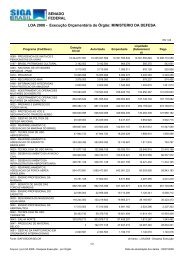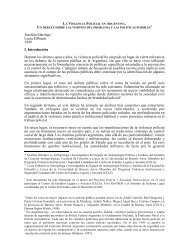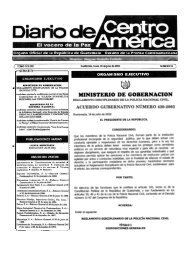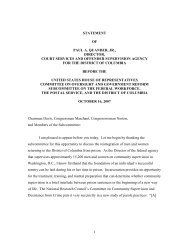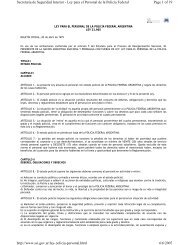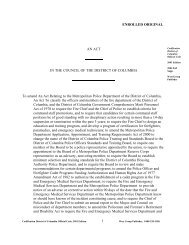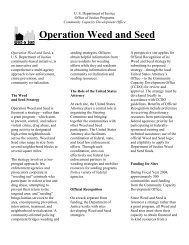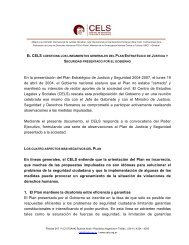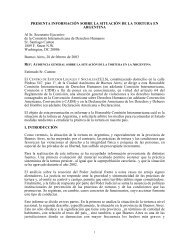Venezuela: The Life and Times of the Party System - Political ...
Venezuela: The Life and Times of the Party System - Political ...
Venezuela: The Life and Times of the Party System - Political ...
Create successful ePaper yourself
Turn your PDF publications into a flip-book with our unique Google optimized e-Paper software.
<strong>The</strong> combined predominance <strong>of</strong> AD <strong>and</strong> COPEI has not been seriously challenged by <strong>the</strong><br />
recent elections. <strong>The</strong> incumbent party has won each time, although since <strong>the</strong> 1989 elections<br />
incumbents at <strong>the</strong> national level have been required to share power in broader <strong>and</strong> more<br />
meaningful senses at <strong>the</strong> regional <strong>and</strong> local levels. In part, this is due to <strong>the</strong> fact that <strong>the</strong><br />
municipal <strong>and</strong> state elections were held less than a year after <strong>the</strong> national elections (though <strong>the</strong><br />
timing <strong>of</strong> <strong>the</strong> elections was not stipulated by <strong>the</strong> law), so that in practice national elections may<br />
have exercised a kind <strong>of</strong> ‘drag’ on <strong>the</strong> subsequent contests. Many believe that <strong>the</strong> separation <strong>of</strong><br />
<strong>the</strong>se electoral contests should serve as a kind <strong>of</strong> plebiscitary mechanism for consultation <strong>and</strong><br />
criticism <strong>of</strong> <strong>the</strong> incumbent administration. However, <strong>the</strong> timing <strong>of</strong> <strong>the</strong>se contests, on <strong>the</strong> heels <strong>of</strong><br />
<strong>the</strong> national elections, can also be viewed as an attempt by <strong>the</strong> larger parties to consolidate <strong>the</strong><br />
results rendered at <strong>the</strong> national level.<br />
Although overall assessment <strong>of</strong> <strong>the</strong>se reforms remains premature, at first glance <strong>the</strong><br />
results appear decidedly mixed. Reforms have clearly increased local <strong>and</strong> regional autonomy,<br />
created new spaces for political competition <strong>and</strong> participation, <strong>and</strong> narrowed <strong>the</strong> distance<br />
between voters <strong>and</strong> elected <strong>of</strong>ficials. At <strong>the</strong> time <strong>of</strong> writing, when many national politicians are<br />
encountering severe criticism, polls show state governors with high levels <strong>of</strong> popularity, much<br />
higher than those going to <strong>the</strong>ir counterparts in Congress. At <strong>the</strong> same time, growing voter<br />
abstention has spurred skepticism about <strong>the</strong> long-term effects <strong>the</strong> reform process can have on<br />
<strong>the</strong> creation <strong>of</strong> new <strong>and</strong> effective channels for popular participation.<br />
In general terms, <strong>the</strong> implementation <strong>of</strong> <strong>the</strong>se reforms has clearly generated a new set <strong>of</strong><br />
dynamics in <strong>the</strong> <strong>Venezuela</strong>n party system. Although <strong>the</strong> overall system remains dominated by<br />
AD <strong>and</strong> COPEI, <strong>the</strong> smaller parties <strong>and</strong> factions are gradually increasing <strong>the</strong>ir participation at<br />
lower levels <strong>of</strong> power. A new generation <strong>of</strong> leaders is clearly emerging, with careers rooted not in<br />
Congress <strong>and</strong> national party machinery but in success with state <strong>and</strong> local-level voters.<br />
Politicians now vie to be c<strong>and</strong>idates for governor <strong>and</strong> mayor, <strong>of</strong>fices not even open to direct<br />
election ten years ago. <strong>The</strong>se changes, including increased power for local leaders (both within<br />
<strong>and</strong> independent <strong>of</strong> <strong>the</strong> parties) <strong>and</strong> <strong>the</strong> emergence <strong>of</strong> new relations among political forces, now<br />
require party leaders to begin crafting new rules <strong>of</strong> <strong>the</strong> game.<br />
Within <strong>the</strong> party system itself, we can observe <strong>the</strong> emergence <strong>of</strong> three political <strong>and</strong><br />
electoral subsystems which, although <strong>the</strong>y overlap to a certain degree, are to some extent<br />
independent <strong>of</strong> one ano<strong>the</strong>r. At <strong>the</strong> level <strong>of</strong> presidential elections, <strong>the</strong> hegemony <strong>of</strong> AD <strong>and</strong><br />
COPEI has been reinforced in recent contests. At <strong>the</strong> level <strong>of</strong> national legislative elections, <strong>the</strong>ir<br />
joint control remains but is now accompanied by a growing tendency toward voter dispersion, a<br />
process that permits greater representation <strong>of</strong> small parties. This has led to new <strong>and</strong> <strong>of</strong>ten<br />
temporary alliance patterns in Congress <strong>and</strong> state legislatures. Finally, although AD <strong>and</strong> COPEI<br />
remain dominant at state <strong>and</strong> local levels, <strong>the</strong>re is a shift in favor <strong>of</strong> smaller parties. New patterns



